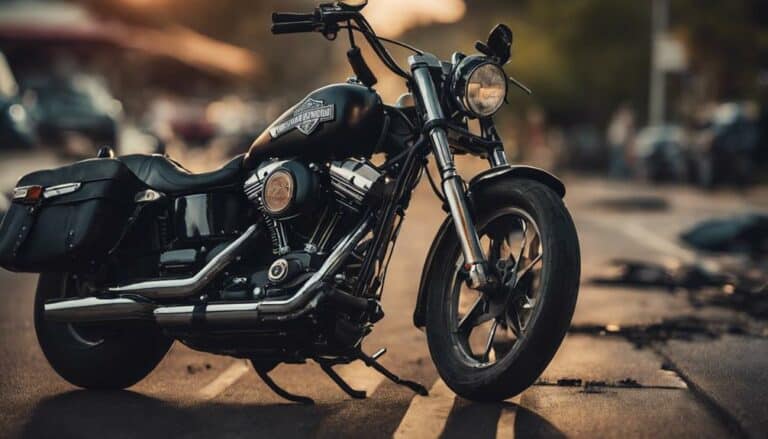When it comes to the world of motorcycles, Harley Davidson's tarnished reputation is like a rusted chain on a vintage bike – once shiny and revered, now struggling to keep pace with the sleek, modern models racing by.
But what exactly led to this downfall?
Stay tuned as we unravel the layers of challenges that have chipped away at Harley's once roaring dominance in the industry.
Key Takeaways
- Past quality control issues during the AMF era impacted Harley-Davidson's reputation.
- Competition from brands like Indian and Ducati challenges Harley-Davidson's market share.
- Outdated branding and customization problems contribute to negative image concerns.
- Customer service challenges and perceived overpricing affect Harley-Davidson's reputation.
History of Quality Control Issues
During the 1970s, Harley-Davidson's ownership under AMF was marred by significant quality control issues, which precipitated a decline in the company's reputation. Complaints about poor build quality, reliability, and customer service were rampant, setting Harley-Davidson apart negatively from everyone else in the industry. Riders reported problems such as leaking oil, electrical issues, and overall manufacturing shortcomings that tarnished the brand's image. The perception that Harley-Davidson was producing low-quality bikes compared to its competitors became widespread, impacting the company's standing among motorcycle enthusiasts. Despite efforts to improve and innovate, the quality control issues of the past lingered, affecting Harley-Davidson's reputation to this day.
The challenges faced during the AMF era highlight the importance of quality control in the motorcycle manufacturing industry. Learning from past mistakes is crucial to rebuilding trust and credibility. By acknowledging and addressing these historical issues, Harley-Davidson can strive to regain its position as a top contender in the market.
Competition and Innovation Challenges
Harley-Davidson's struggles with competition and innovation challenges have become increasingly evident in the face of rising popularity for retro designs from competitors like Indian and Ducati. The design evolution in the motorcycle industry towards vintage aesthetics has attracted enthusiasts, impacting Harley's market share which decreased by nearly 4% last quarter. Despite a strong legacy and brand loyalty, Harley-Davidson faces pressure to adapt to current market trends favoring more personalized and unique experiences. Customization shops have raised concerns about the lack of distinctiveness in Harley's factory-customized bikes, potentially diluting its appeal among riders valuing personal expression.
The over-production of standardized motorcycles might've contributed to this issue, affecting Harley-Davidson's connection with a demographic seeking individuality in their rides. Moreover, the industry's shift towards factory-customized bikes could disrupt the customization culture, posing challenges for aftermarket innovators. To maintain relevance and competitiveness, Harley-Davidson needs to navigate these challenges by balancing tradition with innovation in its design approach and marketing strategies.
Negative Publicity and Image Concerns
Amidst declining market share and revenue losses, concerns over Harley-Davidson's negative publicity and image have intensified, prompting the need for strategic image reformation. The brand's outdated branding has become a significant point of contention, failing to resonate with younger demographics and leading to a perception of being behind the times.
Additionally, customization issues have plagued Harley-Davidson, as factory-customized bikes often lack the uniqueness and personal touch that riders seek. This has impacted the brand's appeal and contributed to its negative reputation.
Moreover, the market share decline faced by Harley-Davidson can be attributed to stiff competition from brands like Indian and Ducati, which offer retro designs that attract a similar customer base. To combat these challenges, Harley-Davidson is actively revamping its marketing strategies to reinvent its image and broaden its appeal, aiming to address the issues that have tarnished its reputation and credibility in the eyes of consumers.
Customer Service and Satisfaction Problems
Customer service problems at Harley-Davidson have been a recurring issue, evident in slow response times, quality concerns, lack of transparency, and communication breakdowns reported by dissatisfied customers. Harley-Davidson customers have expressed frustration over the sluggish handling of their inquiries and issues. Some have raised complaints about the service quality provided by Harley-Davidson dealerships, highlighting instances where expectations were not met. Transparency problems, especially in pricing and service estimates, have further contributed to customer dissatisfaction. The lack of clear communication regarding repairs and delays has added to the negative experiences of some Harley-Davidson owners. Despite attempts to enhance customer service, the brand continues to grapple with challenges in this area, impacting its overall reputation negatively.
| Slow Response Times | Service Quality | Transparency Issues |
|---|---|---|
| Customers report delays in receiving responses to inquiries. | Some customers express dissatisfaction with the service quality at Harley-Davidson dealerships. | Lack of transparency in pricing and service estimates leads to frustration. |
Pricing and Value Perception
Perceived as overpriced relative to competitors, Harley-Davidson motorcycles face challenges in maintaining value perception among consumers. The premium pricing strategy adopted by Harley-Davidson may lead some customers to question the value proposition they receive in return.
Despite the hefty price tag, recent quality issues have further eroded the perceived value of Harley-Davidson motorcycles. Competitors offering similar features at lower prices exacerbate the negative perception surrounding Harley-Davidson's pricing strategy.
The aura of exclusivity created by Harley-Davidson's pricing may not always align with the actual value perceived by all consumers, making it crucial for the company to reassess its pricing strategy to address these perception challenges.
Balancing the perceived value with the premium pricing can be a delicate task in the competitive motorcycle market. Harley-Davidson must strive to bridge the gap between its pricing strategy and the value perception among consumers to enhance its overall reputation.
Conclusion
You have explored the reasons behind Harley Davidson's bad reputation, including quality control issues, competition challenges, negative image concerns, customer service problems, and pricing perception.
By addressing these issues, Harley Davidson can work towards rebuilding its brand reputation and regaining the trust of customers.
As the company focuses on improving quality, innovation, image, service, and value, it can position itself for success in a competitive market.

